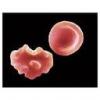Leaderboard
-
Points8,962Posts
-
.jpg.c873029d6ea548a78cb17a21407a1303.jpg) Points2,989Posts
Points2,989Posts -
-
Popular Content
Showing content with the highest reputation on 05/23/2016 in all areas
-
O neg with Ant-c?
O neg with Ant-c?
Teristella and 2 others reacted to yiams for a post in a topic
3 pointsI'm a little late to the party because my wife and I were on holiday. This post caught my attention because we had an O neg patient with allo-anti-c at our facility in 2015. I've attached a .pdf write up I summarized for our CLS students and any generalist in our laboratory who were interested. This is based on the patient history we could acquire and reports from our reference laboratory and the Blood Center of Wisconsin. Del Type.pdf3 points -
O neg with Ant-c?
O neg with Ant-c?
tricore and one other reacted to galvania for a post in a topic
2 pointsWell I am not going to say I 'like' this - I don't 'like' at all that the haematologists haven't seen him. Surely there are only 2 possibilities with that level of drop in Hgb - either he is bleeding or he has a true warm auto immune haemolytic anaemia (or both, of course)2 points -
KB stains... in-house or referral?
KB stains... in-house or referral?
jeloweryii reacted to David Saikin for a post in a topic
1 pointWhose stain are you running? I use Simmler and it always works fine. My staff is all generalists - maybe 1-2/month.1 point -
KB stains... in-house or referral?
KB stains... in-house or referral?
jeloweryii reacted to Teristella for a post in a topic
1 pointOurs are done for trauma patients only, so we do not perform fetal screens at all and they are not sent out. We do them in blood bank and get maybe 2 a year, max. We had so much trouble with our CAP survey this year, once it was submitted we repeated it quite a few times trying to get a decent looking slide and just got nowhere. It's an incredibly frustrating test for us.1 point -
KB stains... in-house or referral?
KB stains... in-house or referral?
jeloweryii reacted to Malcolm Needs for a post in a topic
1 pointAgreed, but, where necessary, we will also perform testing by flow cytometry using FITC-labelled anti-D.1 point -
Further retirement.
Further retirement.
Malcolm Needs reacted to galvania for a post in a topic
1 pointNow why do I think that the NHS is throwing away masses of experience there just to fulfil its bureaucratic rules. (Unless you WANT to retire of course......) But the rest of us will no doubt gain....1 point -
XM GEL AND MEDITECH 5.67
XM GEL AND MEDITECH 5.67
goodchild reacted to Padre Islander for a post in a topic
1 pointMeditech Knowledge Base Article 23147 "Replacing Immediate Spin Crossmathch with AHG Crossmatch" may be helpful.1 point -
KB stains... in-house or referral?
KB stains... in-house or referral?
jeloweryii reacted to Auntie-D for a post in a topic
1 pointLabs in the UK don't use the rosette - we KB all samples where the cord blood is positive. We have national QA to ensure competency (multiple times a year). We are a medium sized maternity hospital and we do 3-4 a day1 point -
O neg with Ant-c?
O neg with Ant-c?
stradfam reacted to Malcolm Needs for a post in a topic
1 pointI think the key to what blood should be given (if, indeed, the anti-c is an auto-antibody) is whether or not the patient expresses the C antigen. If he does, then I would be happy to give c negative units of blood. If he does not, however, I would give c positive blood, because, if he makes an allo-anti-C in addition to an auto-anti-c, finding any blood for him would be almost impossible. Your first sentence is of interest. This is true (in most cases), but an individual who is d(C)ceS or DIII(C)ceS, can make a true allo-anti-hrB that mimics an anti-C+e, and an individual who is hrS negative can make a true anti-hrS that mimics an anti-f, even though they may apparently express c and e in the cis position. However, such mutations are, to all intents and purposes, only found in the Black populations of the world.1 point -
SBB Exam Materials
1 pointI have a copy of "Passing the First Time". Honestly I didn't find it too helpful. Especially since many of the answers were wrong (a known issue for this book). This one was helpful for practice questions, not only did it give you the correct answer, but explained why the correct one was correct and why the wrong answers were not: Transfusion Medicine Self-Assessment and Review, 2nd edition, AABB.1 point
-
SBB Exam Materials
SBB Exam Materials
Monique reacted to Malcolm Needs for a post in a topic
1 pointI agree David. I have read every book I can get my hands on (plus Journals) and I am still learning regularly having been in the game for over 40 years.1 point -
KB stain
KB stain
joe0310 reacted to John C. Staley for a post in a topic
1 pointMalcolm, a fair number of KBs have nothing to do with RhIG. There are emergent situations where they need to know if the blood they are dealing with is mom's of baby's. I know you know this but thought I would point it out anyway. That's what friends are for.1 point -
KB stain
I have been told that we have to do KB because of turn around time. The OB/ER want to know now and do not want to wait a day or so for the flow results...1 point
-
KB stain
KB stain
joe0310 reacted to Malcolm Needs for a post in a topic
1 pointThis is going to send you way over the top then David! In the UK, if the KB test comes out as an estimate of 2mL or more, it is mandatory to send samples for estimation by flow. SORRY!!!!!!!!!!!!!!!!!!1 point -
KB stain
KB stain
joe0310 reacted to David Saikin for a post in a topic
1 pointI am insanely jealous - I keep trying to get one of those but it is futile. That is the way fetal bleed calculations should be done.1 point -
KB stain
We do them because the physician orders them. Most come through the ER as "fall". Many are only 10 or 11 weeks pregnant. I have asked our medical director and he is afraid to confront the OBs because of law suits. That's why I am trying to get ammunition that we do waaaaaaaay too many for no real reason.1 point
-
KB stain
KB stain
joe0310 reacted to David Saikin for a post in a topic
1 pointThere are different reasons for doing KBs: positive fetal screen, abdominal trauma to the mother, versions. The number does seem excessive. I do 1-3/month and am a referral for 3 other hospitals. I like the question from John - Are the docs just ordering them? Get your medical director involved.1 point -
KB stain
KB stain
joe0310 reacted to John C. Staley for a post in a topic
1 pointAre you doing the KBs because they meet a criteria for doing them or simply because the physicians are ordering them?1 point -
Anti M
Anti M
bldbnkr reacted to Malcolm Needs for a post in a topic
1 pointThank you for your kind comment David. Anti-M is the bane of my life! Until relatively recently, if an anti-M was referred to my laboratory, we would test it first by Bio-Rad (Used to be Dia-Med) gel IAT and enzyme technique (enzyme technique to see if anything else is there - even I know that the M antigen is destroyed by papain!!!!!!!!!) to make sure that there was an anti-M present. If there was an anti-M present, we would then test it by pre-warmed, warm-washed LISS tube IAT at 37oC. If we saw no reactions by this technique, we would advise that cross-match compatible blood would be suitable, and safe, for transfusion. If we did see reactions by this technique, we would advise that M- typed blood should be cross-matched, and those compatible transfused. The reason for the difference between the gel technique and the tube technique is two-fold. Firstly, in the gel technique, the reactants (plasma and red cells) are introduced to each other at room temperature, and then the cassettes are put into a 37oC incubator. "Cold-reactive" antibodies can sensitise red cells in "peco-seconds" (I may have exaggerated a bit there!!!!!!!!!!!), but the antibody-antigen complex takes a bit of time to dissociate (longer than the incubation time), and so a "false IAT positive reaction" is seen. On the other hand, if the reactants are introduced to each other, already at 37oC, "cold-reacting" anti-M will (eventually) sensitise red cells, but not in the time allowed for incubation, and so the reaction would be negative. The second reason is that the column containing the AHG is slightly acidic, and if there is one antibody/antigen reaction that likes acidic reactions, it is that between anti-M and the M antigen. I was quite happy with this situation, BUT, and my own line manager is well aware of this, so I don't mind saying it publically, NHSBT has decided, on the grounds that most of our hospitals use gel techniques, we now recommend giving M- typed blood to anyone who has an anti-M, which I think is a total waste of units of blood that have been typed for all sorts of other antigens and have been found to have (presumed) homozygous expression for other, more useful, antigens. I am well aware of the fact that anti-M can cause haemolytic transfusion reactions (IF serologically reactive at 37oC) and can cause clinically significant haemolytic disease of the foetus and newborn (IF serologically reactive at 37oC), and, in the case of HDFN, particularly amongst ethnicities in the Far East, such as the Japanese, irrespective of titre, but these cases are very, very rare.1 point -
Anti M
Anti M
joe0310 reacted to David Saikin for a post in a topic
1 pointI use gel which predisposes for anti-M reactivity. When I find one I perform a strict pre-warmed screen using homozygous and heterozygous cells. If I find reactivity at AHG (using anti-IgG) then I go with antigen negative rbcs/no reactivity I will transfuse ahgxm compatible (prewarmed technique). In my reference experience I have seen folks transfuse M+ rbcs with no adverse reactions. In these instances I have found anti-M that only reacts with homozygous M cells (in gel)and I tell the referral not to be concerned. Sometimes the Medical Director of the referral will call and want M= rbcs; they are usually satisfied if a prewarmed is negative. If I am not finding a pre-existing anti-M I am not concerned. I always like to hear what Malcolm has to say on this (or any) topic.1 point






